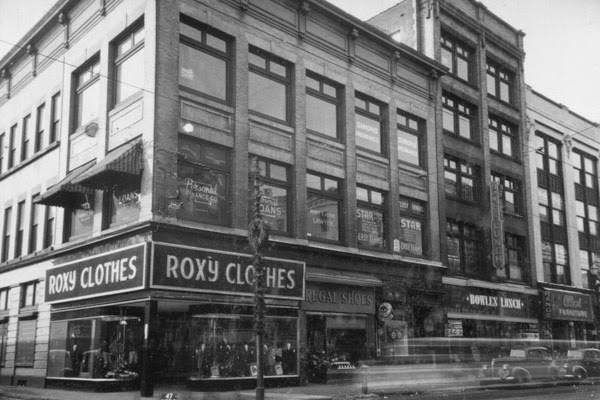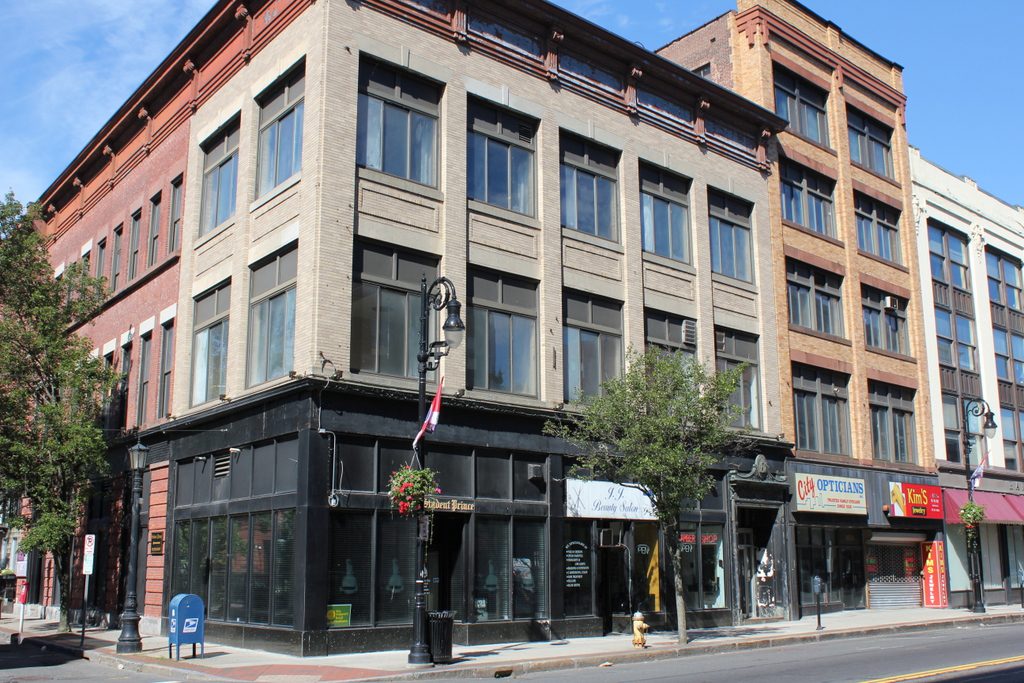The northwest corner of Main and Fort Streets in Springfield, around 1938-1939. Image courtesy of the Springfield Preservation Trust.
The scene in 2017:
The name of this building, the Fort Block, comes from its location on the site of a brick, colonial-era house that had served as a fort during the 1675 Indian raid on Springfield. Built around 1660, the house was probably the only brick building in 17th century Springfield, and this rare luxury reflected the wealth and social prominence of its owner, John Pynchon. He was the son of William Pynchon, who had been the principal founder of Springfield and had built a lucrative trading business here on the colonial frontier. However, William caused controversy with the 1650 publication of his book, The Meritorious Price of Our Redemption, which was declared heretical by Puritan leaders in Boston. As a result, William Pynchon returned to England in 1652, and John succeeded him as both a merchant and as a leader of colonial Springfield.
In 1675, during King Philip’s War, a group of Indians attacked Springfield, killing four residents while burning 25 houses and 35 barns. John Pynchon also lost a corn mill and a sawmill, but his fortified house survived the attack, with its two-foot-thick brick walls providing shelter for many of the town’s residents. In subsequent years, the house became a Springfield landmark, with its role in the Indian raid becoming a part of local lore. It would remain in the family for more than 150 years, and the final owner was William Pynchon (1776-1847), the great-great-great grandson of John Pynchon. The house was one of several early colonial buildings in Springfield that survived into the 19th century, but it was ultimately demolished in 1831.
Following the demolition, the property remained in the Pynchon family for several more decades, and it was finally sold in the late 1850s to the Springfield Fire and Marine Insurance Company. Established in 1849, it was the first insurance company in Springfield, although it lacked permanent offices until 1858, when this commercial block was built on the site of the old Pynchon house. Originally, the building had an Italianate design that was similar to many other commercial buildings of this era and this style can still be seen on the left side along Fort Street. However, the Main Street facade was altered before the first photo was taken, and bears little resemblance to its mid-19th century appearance.
Along with the insurance company, this building also housed the John Hancock Bank, which leased the ground-floor storefront on the right side of the building. Both businesses would remain here for many years, and in 1886 the Springfield Fire and Marine Insurance Company expanded the building along Fort Street in order to accommodate the growing company. However, in 1905 the company built a new headquarters at the corner of State and Maple Streets, and this building was subsequently sold. Early 20th century tenants included Hampden Savings Bank, which was located here from 1899 to 1918; the Bay Path Institute, which moved out in 1922 and later became Bay Path University; and the Springfield Union, whose offices were located here from 1909 until the newspaper was acquired by the Springfield Republican in 1926.
The two other buildings in this scene, on the right side of both photos, are nearly as old as the Fort Block. They were both built in 1864, although, like the Fort Block, they were heavily altered in the early 20th century. The Patton and Loomis Block on the far right, at the corner of Hampden Street, had its facade rebuilt in 1909, and the Loomis Block in between was similarly renovated in 1912, with a new yellow brick facade and a fifth floor. The owners of the Fort Block did likewise about a decade later, adding a new facade on the Main Street side in order to modernize the appearance of the building. However, the older Italianate-style appearance was retained on the Fort Street side, and can be seen on the left side of both photos.
By the time the first photo was taken about 80 years ago, these three buildings had assumed their present-day appearance, and very little has changed in this view since then. All of the Main Street businesses are long gone, including Roxy Clothes, Regal Shoes, and Bowles Lunch, but the Fort Block is still the home of the Student Prince, one of Springfield’s oldest restaurants. Established in 1935 on the Fort Street side of the building, this German restaurant was only a few years old when the first photo was taken, although it is not visible in the first photo. Since then, it has expanded to include much of the ground floor of the Fort Block, and it remains in business as a popular restaurant in downtown Springfield.


